The Tree of Life has been steeped in meaning and symbolism for cultures all across the world for thousands of years and still resonates with people in today’s modern, technological world.
It can be traced back through the Celtic traditions to ancient Mesopotamia, where it held a prominent place in the mythology of Sumerians, Babylonians, and Assyrians. Its meaning would vary, of course, but generally it symbolised the connection between heaven, earth, and the underworld.
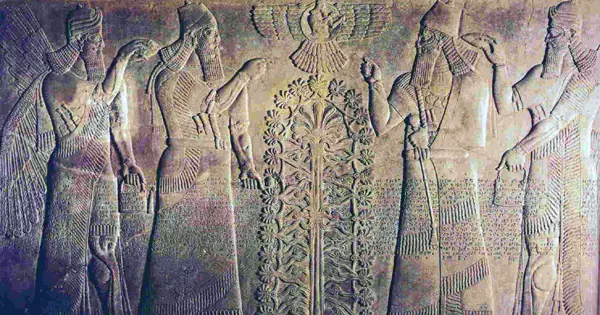
The Tree of Life was also a prominent feature in Norse mythology where it was known as Yggdrasil, a colossal ash tree that served as the centre of the cosmos. Yggdrasil’s branches spread across the heavens, while its roots reached deep into the realm of the dead and the land of giants.
In some ancient African cultures, the Tree of Life represented the connection between the living, the ancestors, and the divine.
The Celtic Tree of Life
The Celtic Tree of Life, also known as Crann Bethadh, is the one best known and most studied in most Western countries today.
It is often drawn showing the branches reaching skyward and the roots spreading out into the earth below symbolising the Celtic Druid belief in the link between heaven and earth.
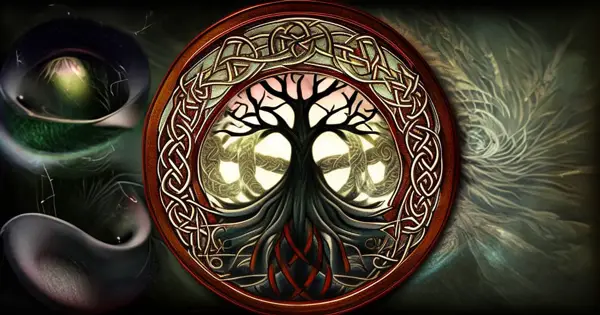
Trees were an important aspect of Celtic Culture. They provided shelter and food, and warmth through firewood. They also acted as a home for other animals, birds and insects.
The ancient Celts revered nature and believed that trees held profound wisdom and spiritual significance. They considered trees as living entities, deeply connected to the land, the sky, and the underworld.
They were seen as sources of medicine, providing for the physical needs of the community. Additionally, trees were considered gateways to the spirit world, facilitating communication with divine entities and ancestors.
Tree of Life as a Cosmic Map

The Celtic Tree of Life served as a cosmic map, connecting different realms and embodying the wisdom of the Druids, the spiritual leaders of the Celts.
It represented the harmony and balance between humans and nature, emphasizing the connection between all living beings.
The Druids would hold their classes and meetings under the trees and, when clearing a settlement, the ancient Celts would always leave a tree standing in the centre.
Celtic connections with the ‘other world’
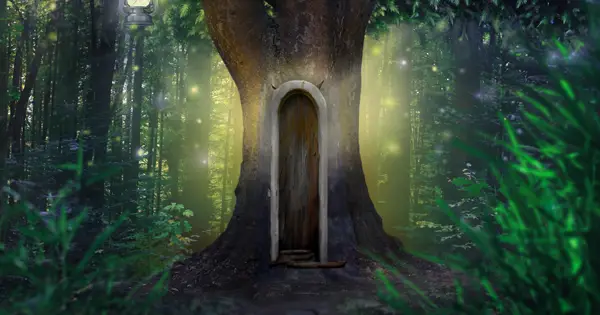
Spiritually, the Celts believed that trees were the ancestors of man and had a connection to the other world.
The most sacred of trees was the oak, or ‘daur’ in ancient Celtic languages, which is where we get the modern word ‘door’.
So the oak tree literally would have been the door to the other world.
Celtic Tree of Life designs
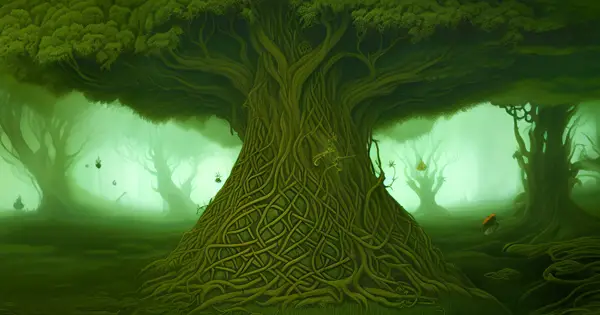
The Celtic Tree of Life is typically depicted as a large tree with its roots deep within the earth, branches reaching toward the sky, and interwoven knots or spirals within its branches. This representation signifies the connection between the physical and spiritual realms, as well as the interdependence of all living things.
The roots of the tree symbolise the underworld, representing the past and ancestors. The trunk represents the present, and the branches reaching upwards symbolize the future and aspirations. The interwoven knots and spirals within the branches represent the eternal cycle of life, death, and rebirth.
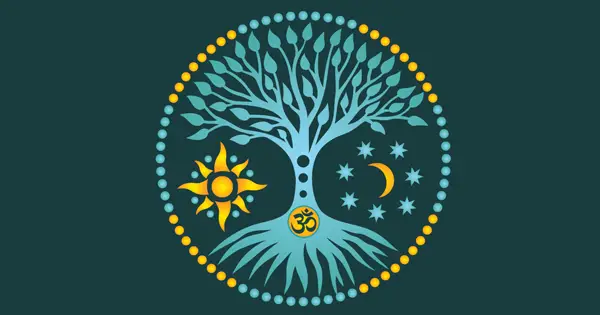
The tree designs vary across other cultures but usually maintain the concept of roots stretching deep towards the underworld and the past, the trunk remaining strong and resilient in the world around us and the branches reaching skyward towards heaven, the future, rebirth and combinations of all three.
Tree of Life in Judeo-Christian tradition
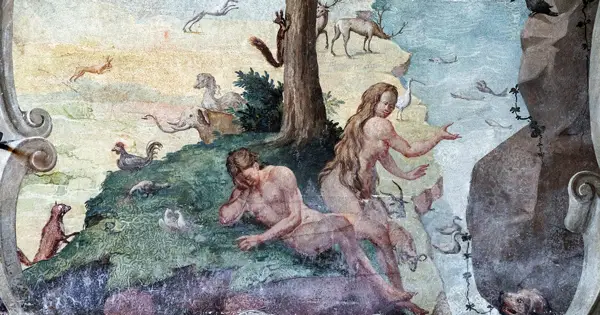
Religions such as Christianity and Judaism see the Tree of Life as a symbol of purity and wisdom.
The tree takes a fascinating twist in the Judeo-Christian tradition where it is seen as the Tree of Knowledge in the story of the Garden of Eden.
As in other ancient cultures, the tree is said to have special powers. God tells Adam and Eve not to eat apples from the tree. It is the only restriction he places on them to test their faith and obedience.
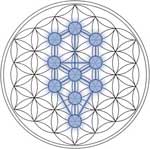
Eve, however, is tempted by the serpent and succumbs in the hope that it will bring her great power on a par with God Himself. Instead, it brings the opposite with Adam and Eve banished from the garden. Eve and every woman following will have to give birth in great pain as a punishment for her disobedience.
Tree carvings from 2000 BC
The remains of tree carvings have been discovered from thousands of years ago.
Neolithic carvings of trees have been found in the countryside of northern England dating back to 2000 BC.

The general meaning of the tree for all cultures is the same; the cycle of life and the interconnectedness of all creation. It’s thought these early tree carvings, no easy task with primitive tools, show the importance trees had in ancient cultures and man’s early attempts to reflect that importance.
Ogham took tree carvings to another level
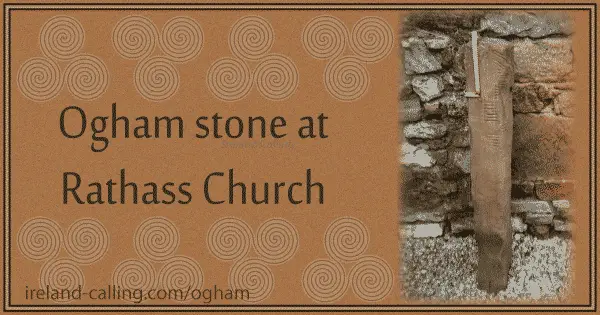
The Celts turned tree carvings into one of the world’s first alphabets in the ancient writing style of Ogham.
The Ogham alphabet named each character after a special tree, so that, in a way, the trees would impart wisdom to those who read it.
The Celts attributed the qualities of wisdom, longevity and strength to several trees. The Tree of Life is not one particular tree or grouping. It can be thought of as a convergence of all trees and to contain all their combined qualities.
Modern interpretations of the Tree of Life
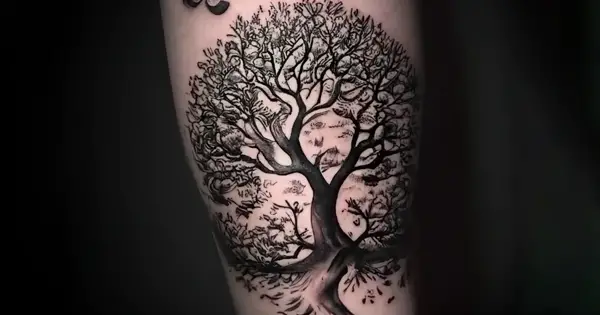
The Tree of Life continues to hold deep symbolism today and resonates with people seeking connection, balance, and spiritual growth.
Many people embrace the Tree of Life as a symbol of personal development, strength, and resilience. Its branches represent personal growth and expansion, while its roots symbolize grounding and connection to one’s ancestry.
The Tree of Life has also found its way into various forms of art, jewellery, and tattoo designs, serving as a reminder of our bond with nature and our inherent place in the world.
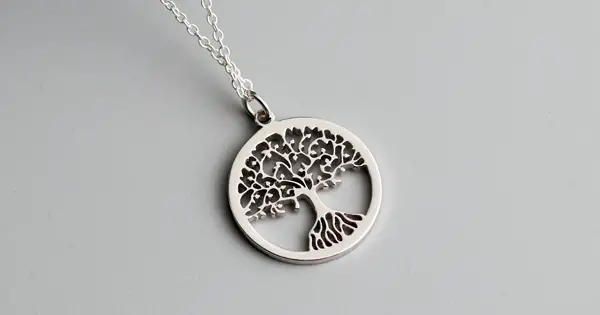
It serves as a visual representation of environmental consciousness and the need to protect and preserve our natural surroundings.
The Tree of Life illustrates the enduring power of ancient symbols and their ability to transcend time.
As we navigate the complexities of the modern world, it reminds us of our interconnectedness and the importance of nurturing our roots while reaching for the sky.
Tree of Life FAQ
The Tree of Life has been an important symbol in different cultures across the world for thousands of years. Even today, it continues to fascinate and prompt questions about its meaning and purpose.
The Tree of Life holds symbolic significance across various cultures and religions, representing unity, growth, and vitality, often seen as a metaphor for the cycle of life and creation.
The Tree of Life is known by different names depending on the culture or religion. In Norse mythology, it is called Yggdrasil. In Celtic mythology, it is named Crann Bethadh. In Christianity, it is often referred to as the Tree of Knowledge or the Tree of Immortality.
The Celtic Tree of Life symbolises the interconnectedness of all living things, representing the union of the physical and spiritual worlds. It signifies strength, wisdom, and harmony, the cyclical nature of life, rebirth, and the eternal cycle of existence.
The Tree of Life is a prominent symbol in Irish culture and folklore, often depicted in intricate Celtic artwork. It represents the connection between all living beings, the continuity of life, and the harmonious balance between the physical and spiritual worlds.
Another name for the Tree of Life is the Axis Mundi, which refers to a central cosmic axis connecting the different realms of existence and providing a link between heaven and earth.
The five sacred trees in Ireland are the Oak, Ash, Hazel, Yew, and Holly. They hold deep cultural and mythological significance, representing various aspects of Irish folklore, spirituality, and wisdom.
The Celtic Tree Spirit is known as the Dryad or the Green Man. It is often depicted as a guardian or protector of the trees and is associated with the life force and vitality of the natural world.
The fairy tree is known as the Hawthorn tree, also called the “faerie tree” or “fairy thorn.” It is believed to be a portal or dwelling place for the fairies and is considered sacred and protected, often associated with magical and mystical experiences.
The Irish god associated with trees is Cernunnos, also known as the Horned One. He is often depicted with antlers and is considered a deity of nature, fertility, and the wilderness.
The exact origin and creation date of the Celtic Tree of Life symbol is unknown. It is believed to have evolved over time within Celtic culture, and its earliest depictions can be found in Celtic art dating back to the Iron Age and the early medieval period.
The Tree of Life symbol is not attributed to a single inventor or creator. It emerged within various cultures and belief systems across different regions and time periods, each adding their own significance to the symbol.
The Tree of Life symbol can be found in various cultures and religions worldwide, including ancient Mesopotamia, Egypt, Persia, India, Celtic and Viking cultures and Native American tribes. Its exact origin and cultural significance may vary depending on the specific tradition.
The Tree of Life symbol offers various benefits, such as reminding individuals of their roots and heritage, providing a sense of stability and strength, fostering spiritual growth, and serving as a visual reminder of the unity of all living things.
Wearing the Tree of Life symbol can be considered positive, as it serves as a personal reminder of the values associated with the tree, such as growth, strength, and interconnection. It can also be a meaningful accessory or piece of jewellery that holds personal significance to the wearer.
A tree is a symbol of hope because it embodies resilience, growth, and the potential for renewal. Even in harsh conditions, a tree can continue to grow, offering shade, shelter, and a reminder that life can flourish even in challenging circumstances.
The Tree of Life can symbolise the divine presence and connection to God in various religious and spiritual beliefs, including Christianity, Judaism, and some pagan traditions.
The root of the Tree of Life represents the foundation, grounding, and connection to the Earth. It symbolizes stability, nourishment, and the link between the spiritual and physical realms.
The study of the Tree of Life is often explored in the fields of mythology, religion, anthropology, and religious studies. It involves examining the symbolism, cultural significance, and interpretations of the tree across different traditions and belief systems.
In Christianity, the Tree of Life symbolizes eternal life, divine grace, and redemption. It is often associated with the Garden of Eden, representing the source of spiritual nourishment, salvation, and the restoration of a harmonious relationship between God and humanity.
The Bodhi tree is the Buddhist tree associated with enlightenment. It refers specifically to the tree under which Siddhartha Gautama, the historical Buddha, attained enlightenment and became enlightened.
In Hinduism, the Tree of Life is known as Kalpavriksha. It is a sacred, wish-fulfilling tree that symbolizes divine blessings, prosperity, and spiritual enlightenment. It is believed to grant the desires of devotees and provide nourishment, shelter, and wisdom.
Ancient ogham alphabet names after Celtic trees
Celtic Cross
Brigid’s Cross
More on Celtic trees folklore
https://ireland-calling.com/celtic-mythology-birch-tree/
https://ireland-calling.com/celtic-mythology-blackthorn-tree/
https://ireland-calling.com/celtic-mythology-heather-tree/
https://ireland-calling.com/celtic-mythology-holly-tree
https://ireland-calling.com/celtic-mythology-ivy-tree/
https://ireland-calling.com/celtic-mythology-mistletoe/
https://ireland-calling.com/celtic-mythology-oak-tree/
https://ireland-calling.com/celtic-mythology-reed-tree/
https://ireland-calling.com/celtic-mythology-rowan-tree/
https://ireland-calling.com/celtic-mythology-scots-pine-tree/
https://ireland-calling.com/celtic-mythology-vine-tree/
https://ireland-calling.com/celtic-mythology-willow-tree/
https://ireland-calling.com/celtic-mythology-yew-tree/
Ancient Irish language of ogham

